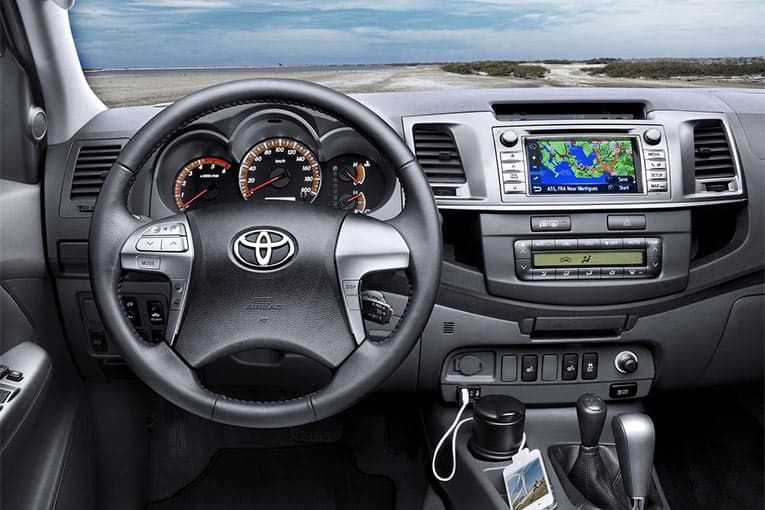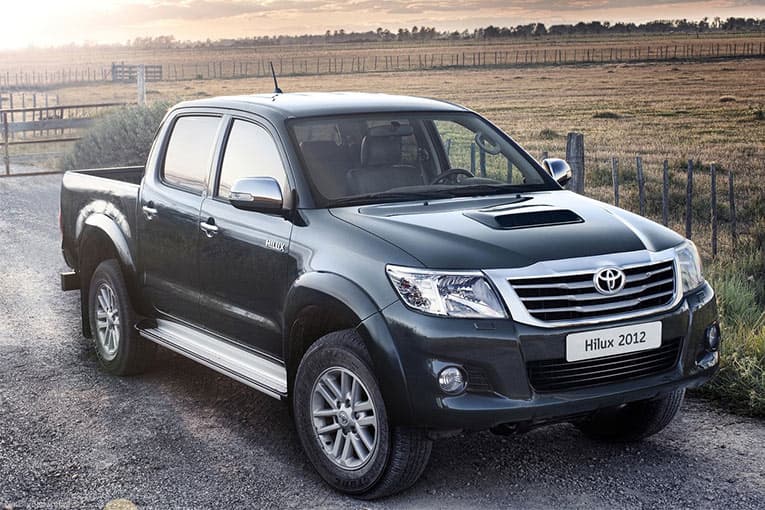Toyota’s workhorse, the Hilux pick-up has been on the market for over 40 years. For the 2012 model year, Toyota Hilux has got some new features for its interior and exterior design. The front of the vehicle is entirely new from the A pillar forwards. This new look combines the image of rugged durability and the vehicle’s SUV-like appeal. 2012 Toyota Hilux has a new bonnet, reverse trapezoid-shaped radiator grille, new headlamps and a new front bumper design with a large air intake and integrated fog lamp housings. At the rear, Hilux has a new rear bumber and new rear lights. On this better equipped SR model, the door mirrors have integrated turn signals, the front bumber is body coloured and the rear bumber is chrome plated.
In Europe, the 2012 Toyota Hilux offers choice of three body types; Single Cab, Extra Cab and Double Cab. Single Cab model has the the longest load deck. This Extra Cab has a bit longer cabin and offers extra storage space behind the front seats. The Double Cab has the biggest cabin and shortest load deck. Double Cab has rear door and offers seating four five persons. As the Single Cab is more of a workhorse, the Double Cab and this Extra Cab are good choices for leisure use also. The same goes with the equipment levels. As the DLX and DLX+ models are designed for work, the SR and SR+ models are more enjoyable and better equipped. The SR model comes with the new Toyota Touch multimedia system that is controlled from the 6.1 inch touch screen interface. Toyota Touch includes a radio/CD/MP3 player, a USB port for the connection of portable music players, a Bluetooth mobile phone connection and a rear view camera. The rear view camera is really useful when parking, although the rear view camera lens gets dirty quite easily. Toyota Touch system can be upgraded also with a navigation system.

The four-cylinder, 2.5-litre, 16 valve, common-rail diesel unit provides 144 horsepower and 343 Newton metres of torque. The engine is paired with a five-speed manual gearbox. With the 144 horsepower Hilux is no high-performance pick-up, but it still is very nice to drive. Especially, as there is a lot of torque available at low revs. Between 1600 and 2800 rpm, you have a 343 Nm of torque, which moves Hilux quite nicely up the hill. The average diesel consumption is 7,3 litres per 100km and the CO2-emissions are 194 g/km. Toyota Hilux is also available with a bigger, 3.0-litre diesel, which develops 171 horsepower. In addition to the manual, there is also a 5-speed automatic transmission option available for the 3.0 D4-D engine.
Toyota Hilux’s 4×4 system offers a choice of three drivetrain modes; two-wheel drive, four wheel drive high ratio and four wheel drive low ratio. Drivetrain modes are controlled by the transfer box lever which is on the main transmission tunnel, next to the gearlever. Two-wheel drive is useful when driving in good road conditions and on a longer journey. It drops the fuel consumption and also the handling is more nimble. When the road conditions gets more challenging, the four-wheel drive mode offers more traction. For more serious off-roading, you can use the low ratio four-wheel drive. At the rear axle you also have the engageable, 100% rear-diff lock. Toyota Hilux has the minimum ground clearance of 212 mm, the approach angle is 30 degrees and the departure angle 22 degrees. At the front axle, Hilux has a double wishbone suspension with coil springs. at the rear axle there are traditional leaf springs with double tube shock absorbers. Toyota Hilux has the maximum towing capacity of 2500 kg.

Specification
Engine
- Diesel
- 4-cylinder
- 2494cc
- Turbo
Power
- 106 kW (144 hp) / 3400rpm
Torque
- 343 Nm / 1600-2800rpm
Transmission
- 5-speed manual
- AWD
0-100km/h / 0-62mph
- 13.3 seconds
Top speed
- 170 km/h
Fuel consumption
- 7.3 l/100km
CO2 emissions
- 194 g/km










